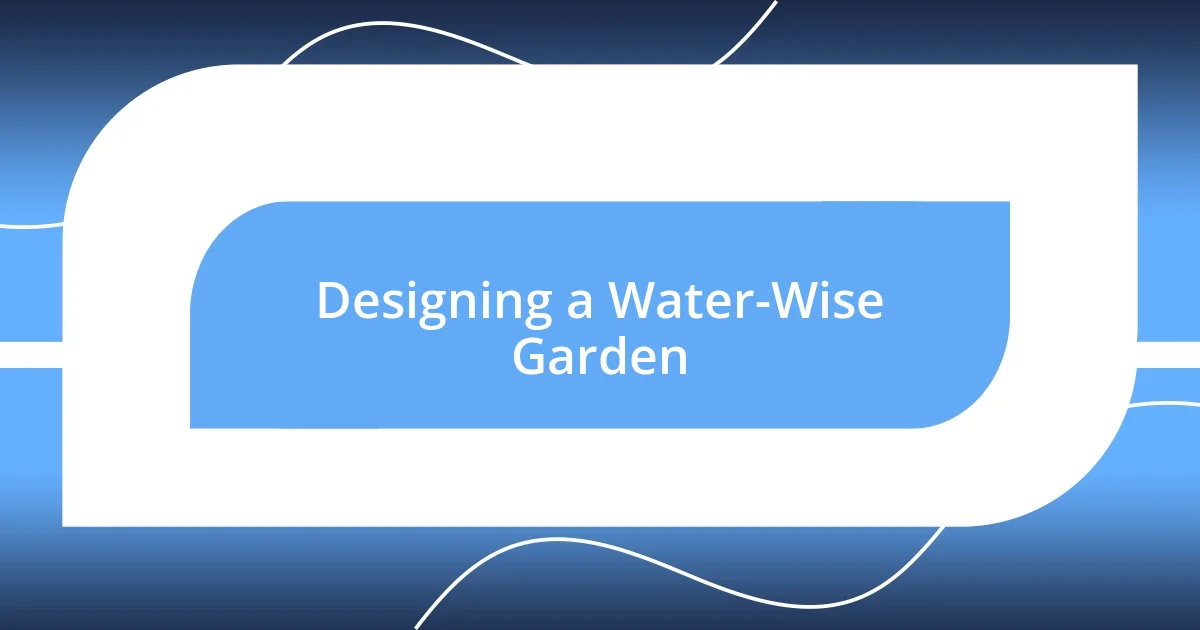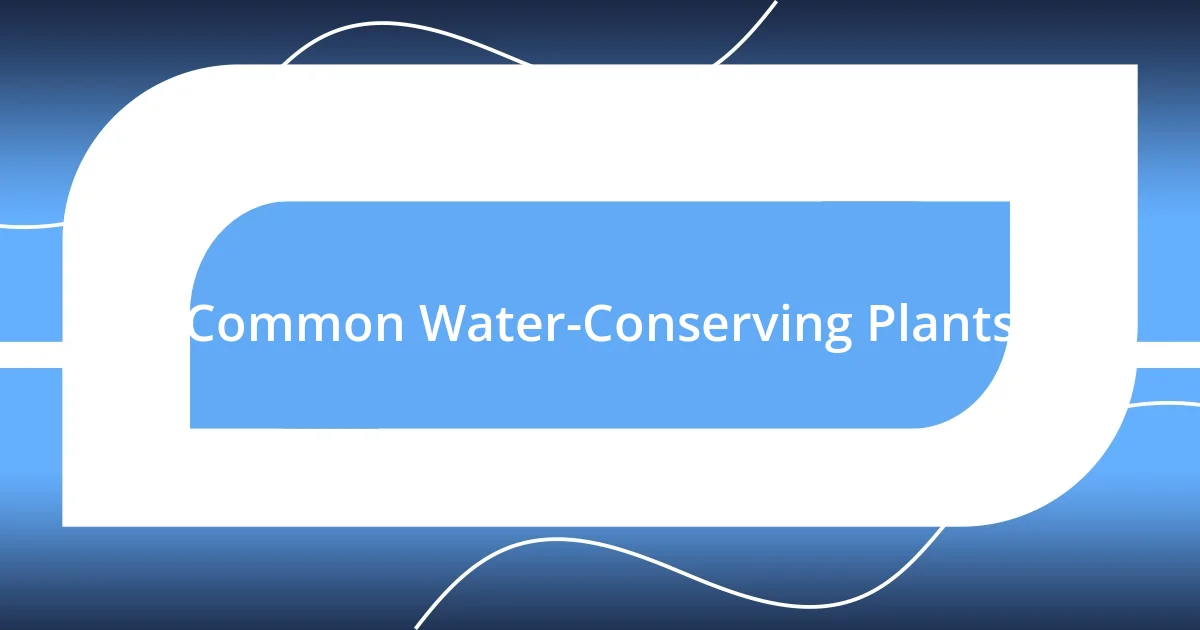Key takeaways:
- Water-conserving plants, such as succulents and native species, thrive in arid conditions and require less maintenance, promoting ecological balance and sustainability.
- Choosing the right plants involves considering local climate, soil type, and future growth, as well as incorporating a variety of species to attract wildlife and enhance biodiversity.
- Effective gardening practices, such as proper watering techniques, companion planting, and mulching, can significantly improve the health and resilience of native plants in water-wise gardens.

Introduction to Water-Conserving Plants
Water-conserving plants are more than just a practical choice for gardeners; they embody resilience and adaptability. I remember the first time I planted succulents in my backyard; I was captivated by their unique shapes and vibrant colors. It got me thinking—why are we not leaning into these hardy green companions more often in our gardens?
These plants thrive in arid conditions, making them ideal for regions where water scarcity is a growing concern. It’s like they have a hidden talent for managing resource challenges. Have you ever noticed how a prickly pear cactus stands tall and proud, even in the harshest sun? That’s its way of telling us that beauty and functionality can coexist harmoniously.
Choosing water-conserving plants isn’t just an environmental decision—it’s a lifestyle change. I felt a sense of pride transforming my landscape into a water-efficient haven. How incredible would it be if more of us joined the movement to adopt these plants, celebrating their uniqueness while contributing to a sustainable future?

Benefits of Native Plants
Native plants offer a bounty of benefits that go beyond their stunning visuals. When I first switched to utilizing native species in my garden, I quickly noticed how they effortlessly thrived without the constant need for watering. Their deep roots help stabilize the soil, reducing erosion and enhancing drainage. Every time I see those plants flourish, I feel a sense of connection to the local ecosystem.
Here are some key benefits of native plants:
- Low Water Needs: They’re adapted to local rainfall patterns, so they require significantly less water.
- Wildlife Support: They provide essential habitat and food for local birds, pollinators, and beneficial insects.
- Soil Health: Their deep roots improve soil structure, promoting better aeration and nutrient absorption.
- Pest Resistance: Native plants often require fewer pesticides since they’ve adapted to local pests and diseases.
- Aesthetic Appeal: They give your garden a unique, natural beauty that reflects the area’s indigenous flora.
Each observation I’ve made while tending to my garden reinforces the idea that these plants are not just survivors; they’re essential players in maintaining ecological balance. I often smile when I see butterflies flitting from one flower to another—knowing that my choice to grow native plants supports their survival brings me joy.

Selecting Water-Conserving Native Plants
When selecting water-conserving native plants, I recommend considering your local climate and soil type. I remember the excitement I felt when I stumbled upon a local native plant nursery. It was like a treasure chest of possibilities, with staff members eager to share their knowledge. Their enthusiasm was contagious! They helped me identify which plants would thrive in my specific environment, ensuring that my choices aligned with the native ecosystem.
Another important factor to think about is the mature size and growth habit of the plants. Early in my gardening journey, I neglected to consider how large my chosen plants would grow, leading to some crowded conditions. I learned that planning for the future helps avoid overcrowding, allowing each plant its space to flourish. While selecting smaller plants might seem appealing initially, I encourage you to look at their full growth potential. After all, giving them room to breathe will lead to a more vibrant garden in the long run.
Lastly, it’s beneficial to incorporate a variety of plant species. By mixing different types of native plants, you create a diverse ecosystem that attracts various wildlife. I was amazed when I started to notice an uptick in birds and butterflies visiting my garden after diversifying my selections. It filled me with a sense of joy to watch the interaction among the plants and the creatures they supported, reminding me how interconnected life truly is.
| Plant Type | Water Needs |
|---|---|
| Prickly Pear Cactus | Low |
| Blue Flax | Moderate |
| Lantana | Low |
| California Poppy | Low |
| Salvia | Moderate |

Designing a Water-Wise Garden
Designing a water-wise garden requires thoughtful planning, and I’ve found that the layout can significantly impact water efficiency. When I first mapped out my garden beds, I focused on grouping plants with similar water needs. It seemed almost trivial at the time, but arranging them by thirstiness not only simplified my watering routine but also helped avoid over-saturation of plants that didn’t require as much moisture. Have you ever noticed how much more efficient it feels when you tailor the garden to the plants themselves?
Creating zones within your garden is another technique I’ve adopted. I learned the hard way that certain areas can retain water better than others, particularly those with more shade. Now, I place my drought-tolerant plants in sunnier spots where they thrive, while shade-loving native plants find their home in cooler areas. This approach has led to a lush, vibrant garden that feels balanced and alive. Each time I walk through it, I’m filled with gratitude for the lessons my plants have shared with me.
Incorporating hardscaping elements—like gravel paths and stone borders—can further enhance a water-wise garden. Initially, I thought these features were purely aesthetic, but they serve a purpose beyond just looks. The gravel allows water to seep gradually into the ground rather than run off, which has made a noticeable difference in keeping moisture levels stable. Isn’t it fascinating how every choice you make can contribute to a more sustainable environment? Every little decision, from plant placement to the materials used, reinforces the commitment to conserve water and support local wildlife.

Caring for Your Native Plants
Caring for your native plants is a rewarding experience that connects you with nature. I remember the first time I walked through my garden, taking note of the little details—like the way the leaves shimmered after a light rain. Regularly checking on them and observing their growth patterns helped me understand their needs better. Isn’t it amazing how spending just a few moments in the garden can deepen your relationship with these plants?
Watering techniques are crucial; I’ve learned to mimic nature by watering deeply but infrequently. At first, I used to water my garden every day, feeling like I was nurturing them. However, I soon realized that this led to shallow root growth. Changing my approach to hydrate less often but more thoroughly has encouraged strong, resilient root systems. Have you tried adjusting your watering routine? It can be a game changer!
Lastly, grooming and maintenance play an essential role in their overall health. I used to hesitate with pruning, worried I might harm my plants. But once I saw how well they responded to a little trimming—bursting with new growth and vitality—I felt empowered. Each snip became a testament to my commitment to their well-being. How gratifying is it to witness such transformation from your care? Embracing these practices truly allows your native plants to thrive, enriching both their lives and your own.

Common Water-Conserving Plants
When I think about common water-conserving plants, certain favorites always come to mind. For instance, I’ve had great success with Agave. Its spiky leaves not only offer a striking visual contrast in my garden but also store water efficiently, making it incredibly resilient during dry spells. Did you know some varieties can survive with very little attention? It truly feels rewarding to have such low-maintenance yet stunning plants thrive under my care.
Another standout for me has been the California Poppy. This bright, cheerful flower bursts into bloom, effortlessly adding color while requiring minimal water. I vividly recall the first spring it flowered; the sight of those vibrant orange petals swaying in the breeze was a delightful reminder of how interconnected beauty and sustainability can be. Have you ever planted something that just brings you pure joy each time you see it? The California Poppy has become a cornerstone of my water-wise garden, symbolizing resilience and cheer.
Lastly, I can’t overlook the allure of Lavender. Not only does it bring a soothing fragrance to my garden, but it also thrives in well-drained soil with little moisture. I remember the first time I harvested my own lavender; the aroma of freshly cut stems filled the air as I imagined all the delightful uses—from culinary to crafting. It’s fascinating how a plant can serve so many purposes while being a champion of water conservation. Have you considered how the right plants can enhance both your garden’s aesthetics and your commitment to eco-friendliness?

Success Stories and Tips
One of my favorite success stories is about my experience with the Desert Marigold. These cheerful yellow flowers blanket my garden in spring, and they thrive with so little water. I distinctly remember the first year I planted them; I underestimated their hardiness. After only a few weeks of minimal watering, they rewarded me with a burst of color that completely transformed my outdoor space. Have you ever been surprised by a plant’s resilience? It felt like they were singing a joyful song of survival, reminding me that sometimes, less really is more.
I also learned the value of companion planting when I introduced Salvia to my garden. These vibrant blooms not only attract pollinators but also help conserve moisture in the soil. I was amazed by how the Salvia flourished alongside my other plants, creating a supportive ecosystem. Watching bees zip from flower to flower was mesmerizing—it reinforced my belief in the importance of biodiversity. Have you explored the idea of creating a community in your garden? Seeing nature interact is an experience like no other.
Lastly, I can’t stress enough the impact of mulch. Initially, I overlooked this simple practice until my neighbor shared her insights. After mulching around my native plants, I noticed they retained moisture much better, and the weeds were kept at bay. The thought of giving my plants a protective layer felt transformative. Have you ever considered how a single adjustment can elevate your gardening game? The satisfaction of knowing I was enhancing my plants’ environment opened my eyes to the profound differences small changes can make.












